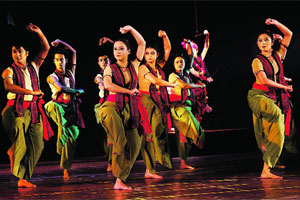Stay updated with the latest - Click here to follow us on Instagram
Dance Craft
It's celebration time at the National Centre for the Performing Arts,Mumbai. Starting from Monday,five consecutive evenings will bring to its auditorium the joys and intricacies of as many classical dance forms.

The Mudra Dance Week focuses on how women artistes have breathed life into classical traditions with their grace and talent
It’s celebration time at the National Centre for the Performing Arts,Mumbai. Starting from Monday,five consecutive evenings will bring to its auditorium the joys and intricacies of as many classical dance forms. The Mudra Dance Weekwhich opens with Manipuri dancer Bimbavati Devis Nrityamalikarolls out Kudiyattam dancer Kapila Nagavallikkunnels Sita Parityagam,Bharat Natyam dancer Lata Surendras Amrutam,Neena Prasads Mohini Attam composition Amrapali and Purva Nareshs Devi,where Kathak meets contemporary theatre. The foot-tapping evenings will have one thing in common: they will be firmly focused on the theme Stree (woman) with women dancers presenting compositions revolving around fascinating women personalities.
monthly limit of free stories.
with an Express account.
The curator of the Week,Arundhati Subramaniam,calls it a celebration of the variety and sophistication of Indian dance styles. The Week is a small but determined attempt to banish cultural cubby-holes of all kinds, she says. The five-day event that coincides with the International Dance Day (on Thursday) attempts to do that with its impressive lineup and post-performance discussions.
A case in point is the Kudiyattam performance. This ancient dance theatre form of Kerala has always been practised in a close-knit group. It has never been a very popular dance form. However,after getting the UNESCO recognition,its domain has widened, says Nagavallikkunnel. Similarly when Bimbavati Devi takes to stage,she will provide a glimpse into the well-researched style followed by her father and Manipuri dance exponent Guru Bipin Singh. Manipuri dance has been perceived as slow and monotonous. Many have tried to break this by showcasing the richness of the Manipuri style, she says.
The result of such efforts to entertain and educate the audience could be the reason why Prasad notices an increase in an academic sensibility towards classical traditions. The taste in classical dances has further developed in recent years. As a result,lesser-known classical dance forms like Kudiyattam or Nangiar Koothu are finding newer platforms, she says. Prasad,who is performing after a long time in Mumbai on Thursday,has experimented with stories of many female personalities. Initially,I considered presenting my composition Draupadi but settled for Amrapali as I thought it will strike a chord,thanks to Vyjayanthimalas performance in the film named after this Buddhist monk, says the Mohini Attam exponent.
Apart from showcasing these powerhouse performers,the Week will also help dance lovers take stock of how these practitioners of classical traditions have bridged the gap of past and present with their experiments. The classical element remains permanent. But instead of a nearly three-hour performance,it has now reduced to less than two hours, says Prasad. Naresh and her team of young dancers offer more insight into this trend. The ensemble of dance theatre and storytelling in one production makes for engaging viewing, she says. The Kathak dancer also feels that the merger of classical elements with those which are not,makes for an interesting fusion.
Despite the burst of modern dance shows on every possible platform,classical dance still holds fort. And celebrations like the Mudra Week serve as a reminder of this.